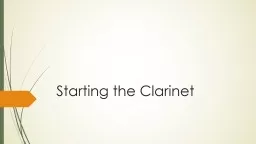PPT-Starting the Clarinet
Author : pasty-toler | Published Date : 2017-10-28
Recordings https wwwyoutubecomwatchvogm0NCabPs https wwwyoutubecomwatchveFHdRkeEnpM Groups Group 1 Kylan Celia Amy Daniel Cadence Nathan Michaela Leiland Jalen
Presentation Embed Code
Download Presentation
Download Presentation The PPT/PDF document "Starting the Clarinet" is the property of its rightful owner. Permission is granted to download and print the materials on this website for personal, non-commercial use only, and to display it on your personal computer provided you do not modify the materials and that you retain all copyright notices contained in the materials. By downloading content from our website, you accept the terms of this agreement.
Starting the Clarinet: Transcript
Download Rules Of Document
"Starting the Clarinet"The content belongs to its owner. You may download and print it for personal use, without modification, and keep all copyright notices. By downloading, you agree to these terms.
Related Documents














